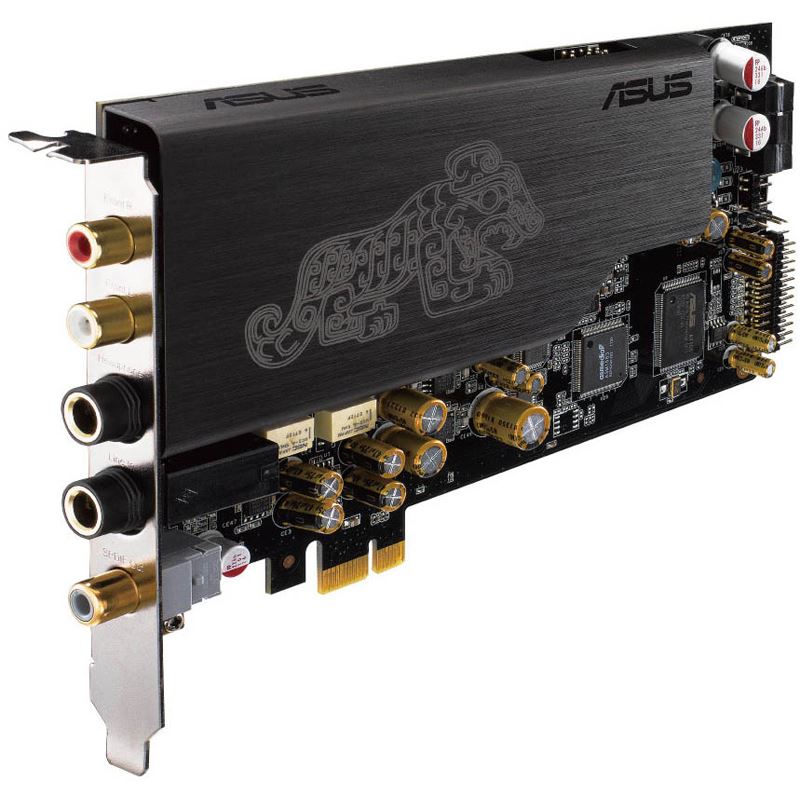 Upgrading an Asus Essence STX II with Burson Audio Supreme Sound V6 Vivid opamps
Upgrading an Asus Essence STX II with Burson Audio Supreme Sound V6 Vivid opamps
As promised, here is a small thread about upgrading an Asus Essence STX II sound card with the Burson Audio Supreme Sound V6 Vivid opamps.
In my recent journey into digital audio, I came across a bargain sound sound on Amazon on one of their offer days. The Asus Essence STX II. This is a highly regarded sound card over on HeadFi, so I thought I would take the plunge.

The Asus STX II.
The tech specs:
Audio Interface - PCI Express
Audio Performance: Output Signal-to-Noise Ratio (A-Weighted): 124 dB
Output Signal-to-Noise Ratio (A-Weighted) (Headphone-out) : 120 dB
Input Signal-to-Noise Ratio (A-Weighted) : 118 dB
Output THD+N at 1kHz (Front-out) :>0.0003 %(-110 dB)
Output THD+N at 1kHz (Headphone-out) : >0.001 %(-100 dB)
Frequency Response (-3dB, 16bit/44.1KHz input) : 10 Hz to 90 KHz
Output/Input Full-Scale Voltage : Line output (RCA, 3.5) : 2 Vrms (5.65 Vp-p)
Headphone output : 7 Vrms ( Vp-p)
Chipset
Audio Processor :24-bit D-A Converter of Digital Sources: TI Burr-Brown PCM1796 (123dB SNR)
Digital-to-analog Converter(DAC) TI Bur-Brown PCM1792A
Sample Rate and Resolution
Analog Playback Sample Rate and Resolution : 44.1K/48K/96K/192KHz @ 16bit/24bit
Analog Recording Sample Rate and Resolution : 44.1K/48K/96K/192KHz @ 16bit/24bit
S/PDIF Digital Output :44.1K/48K/96K/192KHz @ 16bit/24bit
ASIO Driver Support : 44.1K/48K/88.2K/96K/176.4K/192KHz @ 16bit/24bit
Connectivity
Analog Output
1 x 6.3 mm jack (1/4") Headphone out
2 x RCA (Un-Balanced)
Analog Input
1 x 6.3 mm jack (1/4") (Line-in/ Mic-in combo)
Digital
1 x S/PDIF out (1 x Coaxial)
1 x Front-Panel Header
Special Features - Dolby® Technologies : Dolby® Digital Live/Dolby® Headphone /Dolby® Virtual Speaker /Dolby® Pro-Logic II
A very good specification for a sound card I thought.
So I bought it, and it arrived quickly. I then did a comparison with my Caiman SEG with linear PSU, and decided that for the difference in price, I was very happy with the Asus Essence - (thread can be found here https://theartofsound.net/forum/show...ality-from-USB
A few weeks passed, and I was enjoying the convenience of digital audio, with quality sound. I started opamp rolling (different opamps are supplied with the card, with the tools to change them) and remembered a company called Burson Audio that did some nice opamps for Audio purposes. I contacted Charles, and he suggested that I tried the Supreme Sound V6 Vivid in my card. I ordered the three needed, and sat back waiting for the delivery. Deliverey was really quick and they arrived very well packaged.

All that was left to do was to install them.
Before ordering them, I had done a quick measurement to see if they would fit (as can be seen in the photo, they are quite tall) and from a rough measurement it seemed like it would be a tight fit, but should be ok.
I whipped the sound card out of my PC, and removed four screws to allow access to the Opamps.

Back of the card, showing the screws to be removed.
This gave me access to the Opamps.

The original Opamps can be seen in the upper left part of the card.
I removed these with the pliers supplied with the sound card, and fitted the V6 Vivid Opamps.

The big red blocks are the Opamps.
I fitted the sound card back into my PC and it was a tight fit. A bit too much pressure was being but on the PCB as I had a minor clearance issue of a couple of millimetres.
As it was in, I fired up the PC, and played some FLAC files and it was an immediate improvement in the sound. I was extremely happy with the sound, but not too happy I had not measured the clearance properly.
As the music server is in an old PC case, I modified the case to provide better clearance by cutting a hole in the bottom of the case.

The actual case I want to use has the PSU in this position, so I will be unable to do this, so I either need to change the motherboard on my old PC (if I can find a suitable one on eBay at a sensible price) or order a set of extenders from Charles, as this will resolve the issue by allowing me to relocate the Opamps.
As for the sound, well it became obvious that there was more clarity. This allowed the detail to be communicated easily to the listener. The sound became more open. There was more of a 3D image to it. I enjoy the music more, as it seems more real. It does seem to be improving slightly as time goes on. I probably have about 50 hours on the Opamps and I am happy. They probably need quite a few more hours to bed it properly (or is it me that needs the hours?) and I will then rerun the comparison with my SEG to see if this lifts the overall quality of the sound. For this, I will order the SEG30 firmware, and I will contemplate purchasing the Dorado PSU.
On a final note, these Opamps lifted the sound quality and my enjoyment of the music.
I thoroughly recommend them, and I am currently thinking about modifying my PD-S703 with some Supreme Sound Opamps.
Kevin
Too busy enjoying the music....
European loan coordinator for Graham Slee HiFi system components..











 Reply With Quote
Reply With Quote